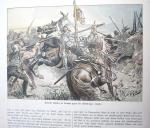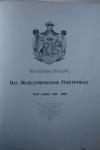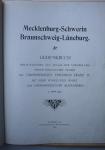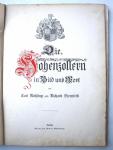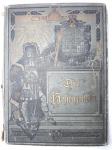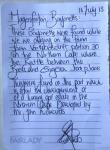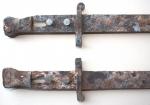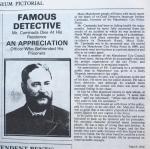-
Posts
13,225 -
Joined
-
Last visited
-
Days Won
22
Content Type
Profiles
Forums
Blogs
Gallery
Events
Store
Everything posted by Mervyn Mitton
-
Sorting through a cupboard in the shop which had old books stored , I found this beautifully produced volume on the famous Hohenzollern family. Printed in 1904, every page has an illustration showing members of the family - all painted by the same artist. Attached are the front introductions and just some of the page pictures. For it's age it is in fair condition and I am thinking our sales section might find a home - what do you think would be a fair price ? Mervyn http://gmic.co.uk/uploads/monthly_07_2013/post-6209-0-59348000-1374505209.jpgclick
-
http://gmic.co.uk/uploads/monthly_07_2013/post-6209-0-25330700-1374501707.jpgclick This could be a Victorian truncheon - but, is more likeley to be for William 4th (1830-37). painted black - the arms are in the lower area. Named CHIPPENHAM HUNDRED CONSTABULARY - this was an old Saxon name , going back over a 1000 years. Basically, it is the counting together of 100 houses or, homes and appointing one of the householders to be the Tything Man or, Parish Constable for that area - the local Church was usually the centre. This is rare to be named for a Hundred - I think Chippenham is in Wiltshire. The plural of Constabulary is unusual, normally there would only be one man. However, it is likely a small town could have more - each in his own part of town.
-
Now we come to the two buried and damaged bayonets. They are Martini Henry 1888 pattern - 2nd pattern. These were the bayonet used on the Lee Metford. Without doubt thay are from the Highland Brigade and from soldiers killed in action. How can I tell that ? Deduction. The bayonets were found without scabbards - so they would have been fixed to the rifles. When their owners were killed, the rifles and bayonets would have been left in situ. The Boers never used bayonets - so, they would have collected the rifles and left the bayonets. The lady who brought them in dug them up herself with her husband. They were clearing for a golf course and using a JCB. This accounts for the broken blade. She has given a letter of authenticity. I regard these as important relics - ones that have a sad and poignant story with them. I will ensure that they are treated with great respect. http://gmic.co.uk/uploads/monthly_07_2013/post-6209-0-15031100-1374158295.jpgclick
-
http://gmic.co.uk/uploads/monthly_07_2013/post-6209-0-31080800-1374155312.jpgclick When the Boer War commenced in 1899, the Boer regular Forces were more prepared then the British. This was clearly seen when they besieged Mafeking - Kimberley and Ladysmith. Kimberley was in the Cape Colony and the loss of revenue from diamonds and gold was very serious to our war efforts. Major General Lord Methuan was given 8000 men - including a Brigade of Scottish Regiments - and was told to relieve the Siege. His opponent - General De la Rey , led 9000 Boers. The Briish were equipped with the 10 round Lee Metford rifle whilst the Boers used mainly the Mauser and additionally, older Martini Henry rifles. The Boers had just pulled off a coup by buying and landing safely, 30,000 Mauser Rifles together with ammo. - plus, in addition a range of French and German Field Guns, in varying sizes. 11th.of December 1899 - our troops were marching to the Relief of Kimberley - they were 6 miles (app.8Kms) North of the Modder River - which was in the North West of Cape Colony and near to Kimberley. The land was mainly dry, flat veld - or, plains and across this flat expanse were a series of low hills. The Boers were ready for the British attack - you would have expected them to be on the hills for better range - however, they had dug trenches at the foot of the hills. This took the British Artillery by surprise as they laid down heavy fire on the tops of the hills - leaving the Boers almost untouched. With the hindsight of History, it is easy to make derogatory comments about the Generals - however, it is generally admitted that our leaders were always still fighting the last campaign. This was unfortunately to be the case at the Battle of Modder River. Discussion was held amongst our Generals on how best to keep casualties down as the advance was made on fixed positions. Chief amongst these was the need to keep open order and take advantage of the land. This was not to be - The Highland Brigade - under Major General Wauchope - a famous hero of his day - advanced on the Boer positions in close columns. They were pinned down and exposed to heavy fire for over 9 hours . With many casualties, the Highland Regiment fell back and withdrew We had been badly beaten. The Highland Brigade lost 53 Officers and 650 men. Brig. Wauchope and three Commanding Officers were killed. A total of 948 British officers and men were killed or, wounded. The Boers had 236 killed.
-

just bought helmets
Mervyn Mitton replied to blueman's topic in Great Britain: Militaria: Badges, Uniforms & Equipment
I would have said the Crown on both was the King Edward - and therefore QE2. Mervyn -

Unidentified Need help with this medal
Mervyn Mitton replied to danio's topic in Great Britain: Orders, Gallantry, Campaign Medals
Danio - I'm afraid that Rick is correct. A commercial item and probably not silver - so, sentimental value only. Probably dates to WW2 - St. Christopher's were worn as he was the Patron Saint for travellers. Mervyn -
Hi John - welcome to GMIC. A nicely made award - the missing suspender was probably a ring to hold a ribbon. Great numbers of competitions used to be held both in-Service and between Services - they rarely have a high value - unless of course they were gold. Silver was common, however, this one appears to be copper. I can't think what 'CC' would stand for - hopefully one of our Members with a Naval interest will be able to help. Mervyn
-
This is an old post - however, whilst looking through some old papers I came across this obituary for Caminada. The publication it was-in was to publicize the Manchester Police Museum - I will post further items of interest in the future. Having this with the original post gives a conclusion to his story. http://gmic.co.uk/uploads/monthly_07_2013/post-6209-0-74936000-1373895360.jpgclick
-
INTRODUCTION A Member kindly told me recently, that this Blog is a part of Social History. I hadn't thought of it in this way - however, I suppose it will prove of interest to some Police researchers and perhaps, younger Policeman. The simple fact is that this happened to me personally, 47 years ago ! Since I was to spend the next 7 years there - here is a little history on the area. The East End of London is to the left of the Tower of London - if you were facing the River Thames. Originally - in the time after King William 1st. (1066) it was reserved as a hunting area for the King. Gradually, it became a number of small market gardens , producing fruit and vegetables for London. However, large parts still belonged to the Sovereign and were administered by the Crown Estates. The whole area was quite run-down and in 1968 large parts still had serious bomb damage from WW2. Despite the poorness of the area, most people were still staunchly Royalist - and some-what grudgingly, accepted 'us' , as 'their' police. I have always found it strange how people's opinion of the Police changes quickly when they need help. The Royal Mint Map in 1833 The Royal Mint in 1833 The Royal Mint used to be on the left of the Tower - and was there for many years , before going to Wales in the 1970's. Prior to that it was with-in the Tower. The area around the Mint was an ancient one - still known today as the Minories - it was in fact an Abbey for the Minor Prioresses of the Order of St. Mary - created in 1494. Sometimes distinguished people who were beheaded in the Tower , were allowed to be buried with-in the Minories. This beheaded scull is believed to be that of the Earl of Suffolk -- Lord Grey. He was the Father of Lady Jane Grey who seized the Thone for nine days. They were both beheaded. When I was at Bethnal Green, the Governor of the Mint had the 'bad' habit of calling an 'Emergency' and then standing at the gates with a stopwatch. You had 3 minutes to get there ! I can remember some very frightening 80mph (140kph) across the East End to avoid an enquiry . The Area Car for HB had the call sign 'Hotel 2' - perhaps it still does ? It was one of three fast pursuit cars for the Division. They were Jaguar 2.4's at that time. Moylan Police Section House was on a small turning off of the Ratcliffe Highway . This was an old road that ran between the Tower and the Isle of Dogs and the West India Docks. Because it was an important road - with numerous cross-roads it became known for it's illegal burials. Suicides and executed people were not allowed to- be buried in Consecrated soil. The few that were allowed at the Minories, probably cost a great deal of money. The next best thing was a cross-roads - with it's shape as a Cross. Also, in this vicinity was the important Parish Church of St. George's East - it lay alongside the Highway. Over the years many bodies were buried at night - and are still often found when the road is dug-up. St. Georges in the East - 1729 These two tipstaves for St. Georges date back to 1848 &9. Given each year by the Churchwarden to the in-coming Parish Constable Having always had an interest in History I found the whole area to be full of old monuments and buildings. Should we continue with the Blog I will talk about some of the 'hidden' areas - the thing with London is that we have over 2000 years of continuous habitation and in the older parts so much of it has survived. I START DUTY Having settled in at the Section House, I had quickly discovered one serious problem. No under- cover parking. I had a Triumph TR4a sports car with a canvas hood at that time and quickly realised that it wasn't suitable. I changed it for a Singer Vogue - same as the Hillman Minx , but a little more varnished wood on the dash. A great car and although I missed the exhaust note of the TR - and the acceleration, it never let me down and with a friend from the Station we took it on a trip right through Spain and Morocco. With the Section House we each had our own rooms, a nice canteen , TV room (if you liked Football...) laundry rooms and a small yard for cycles. A Sergeant was in overall charge. These Houses were an idea from Victorian times - they gave young constables somewhere to live - and in an emergency a considerable body of men were available at short notice. We shared large bathroom facilities and I have quite fond memories of the place. We were from Stations all over the Division so, it was a way to make friends - and find out the 'gossip'.............. Bethnal Green's call sign on the radio was in the military alphabet - 'HB' - 'Hotel Bravo'. This stood for Bethnal Grren Police Station and 'H' Division. The Station has moved now, so this may have changed. However, I will in future use these initials for Bethnal Green. Incidentally, a Bethnal - in medieval language was a mental hospital. Any new person , to any job, is wise to take things slowly and let people get to know you. I think this is advice some of new members on GMIC should remember. I know it took a few months until all of the older PC's gave full acceptance. For the first month new Constables are posted with an older, experienced Constable. This period is called 'Teaching Beats'. He sets the hours and you are separate from normal activities. The idea is for you to learn the streets and the area. Also, to deal with as many different incidents as possible to give experience. I was with a 20 year service Constable - we will call him Jock. He was to become a good friend and knowing the 'job' so well, was a great mentor. He certainly knew every place we could get a cup of tea on a cold, wet day ! I was amazed to find that we had three of Jack the Ripper's murder sites on our Ground (meaning our Station's area) There were always members of the public asking for directions - and if we had time it was nice to spend a little time telling them local history. One site - the house in Hanbury Street - was still exactly the same as the full page drawing in the Illustrated London News from 1888. This was where Annie Chapman was dismembered on 8 Sept. 1888 - the address was 29 Hanbury Street. Developers later pulled it down - but, I have been told that it is to be re-built ? 29 Hanbury St. 1888 The backyard. She was killed at the bottom of stairs. We were walking back to the HB one morning when we spotted a big old Cadillac - mind you, it was probably new in those days. Bright pink and with the tall tailfins. It was parked outside a house in Vallance Road - where the Kray Brothers Mother lived. We walked over and were looking at the car when the Kray twins - Ronnie and Reggie - came out. We spoke generally and they wished me well. They hated the CID but, were very careful with Uniform Branch - we could have stopped them every few yards. The Kray Gang was at it's peak at this time. Enormous investigations were being made of the various murders. I was told that Police believed they carried out far more then could be traced back to them - but, that's just gossip. Jock had shown me the bullet holes - still ringed with Police chalk circles, in an old wall where Jack 'the hat' McVity had been killed quite recently. There was also a search for one of their hitmen who had gone missing. Rumour had it that he was dropped into bridge foundations on the M1 . A Pub in Mile End Road - The Blind Beggar' - used to have a framed bullet found behind panelling. This is where they claimed he had been shot. The owner's claimed the Police missed-it. Who knows ? Next Chapter I join my 'Relief' ( the name for the patrol unit - at that time there were three giving 24 hour coverage) at HB and go on Patrol on my own.
-

.410" Lee Enfield
Mervyn Mitton replied to muckaroon1960's topic in Great Britain: Militaria: Badges, Uniforms & Equipment
Hi - that's an interesting conversion and one I haven't seen before - although I expect you will tell me that they are quite common ? I carried this rifle during my National Service in Australia - I can still remember the weight of the damned thing - 9 pounds 4 ozs.. 410's are not to be underestimated - years ago in Bournemouth I had a problem with squirrels breeding out of control. Eating all the bird seed and breaking the feeders was one thing - but, they were also destroying nests and eating the baby birds. The little shotgun took 50 out in two months and restored the status quo. I surrendered it when I came to live here - it was what was called a ' poacher's ' gun as it folded totally in half for concealment under a coat. Best wishes Mervyn



